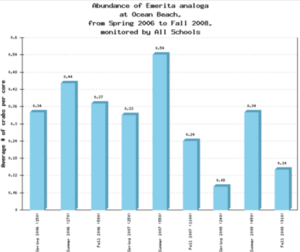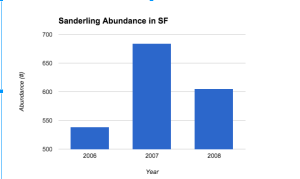by Miles, Sophia, and Charlie
Bishop O’Dowd High School
A sharp, cold wind rips across the beach, chilling the shivering O’Dowd students to the core. But there is no room for weakness. The research must be conducted at any cost. As the oceans continue to be examined, the relationship between sand crabs and sanderlings remains unclear. The two species are locked in the age-old, evolutionary battle of predator and prey, but the other aspects of their interactions are unknown. Exploring the correlation between the abundance of sand crabs and the abundance of shorebirds on Ocean Beach is a key component of understanding the beach as a whole. This research is vastly important, as sand crabs act as prey for many species on the sandy beaches, and serve as an indicator species, or a species that serves as a gauge for a habitat’s health.
Questions on the specific correlation between the number of sand crabs and shoreline birds has also come into focus. The sand crabs are highly affected by the waves and the tide, so they tend to form dense “aggregations” in the wave-washed intertidal zone. This makes it very easy for birds to feed, and shorebirds with aggregate around the groups of sand crabs. Overall, there is a positive correlation between shorebirds and sand crabs. Research shows that the sanderling and sand crab population correlate in numbers, which was discovered through investigating the beaches of the California West Coast.
In our own research at Ocean Beach, we took cores of sand and counted the density of crabs along the swash zone – at the top of the waves where sand crab aggregations tend to occur. We looked at sand crab data, collected the same way, from 2006 to 2008 and compared it to data on sanderlings. There was a small spike in both populations from 2006 to 2007, and a decrease in population levels from 2007 to 2008. This indicates a small positive correlation between the populations, as they both increased and decreased in tandem. This is likely due to the dependence they hold with each other. When the sand crabs are absent, so are the sanderlings. This might occur because the sanderlings rely on the sand crabs as a huge food source. In conclusion we found that there is a positive correlation between the sand crabs and sanderlings due to the way they rely on each other for survival.




































This is amazing research that you have conducted. It is fascinating and so very important. You should all consider a career in the sciences, Marine biology in particular . We all need bright, caring scientists like you are!
I love the first few introductory sentences; they provide a great hook that drew me into your blog and were an intriguing transition to your research! I agree with your conclusion that the fluctuating populations of sanderllings and sand crabs have a positive correlation because of the hunter/prey relationship. When there are more prey, it makes logical sense that more predators would be present, and when there is less prey, the population of predators decreases in response to less food. Very interesting research!